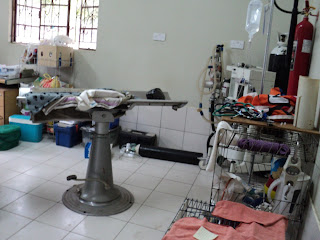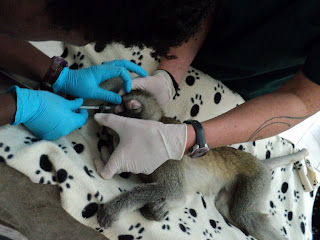 |
| A proper professional python in a zoo |
Henry was due for a feed - yes, that is his name, and for some reason it always conj ours up for me the image of a snake with a bowler hat and bow tie. Feeding happens once every 2 weeks,although just as an aside did you know that a python can live for a year without eating if he has just had a really BIG meal? Anyway, I digress. Today he was to be fed and this meal was to consist of a dead chicken. What happiness. I planned to worm (no pun intended) out of my other duties to see the feeding because I wanted to see him detach his lower jaw, somehow slide along the floor and scoop up the chicken, and then watch the lump travel down his body. But I couldn’t get away on time, and anyway there was a huge crowd of manky school children all clustered around him and getting in the way, meaning I wouldn’t have got to see much. So I went a couple of hours later. When I got to the enclosure, this is what I saw:
A large, open enclosure with trees and water and grass and plants and bushes and flowers and lots of other attractive things
A large black car tyre, lying flat
A dead chicken inside the car tyre
No snake
Then my companion pointed out that the snake was inside the car tyre, the chicken effectively curled in its folds. My companion added that the snake did not eat while the children were there because once he has eaten, he will not be able to move for a while so will be vulnerable to prey. I sympathized enormously with this, because after I’ve eaten I often can’t move for hours, and insensitive people of low intelligence often use such times to ask complex and tedious questions and demand things of me. I felt a bond between myself and Henry right away. We sent each other vibes for a few moments through the tyre about being too sensitive for this harsh world. And my friend then buggered off.
However, despite the warmth of our instant bonding, Henry did not then immediately pop out to see me and wave his chicken in triumph. This was slightly disappointing. I watched the dusk begin to settle, and the noise of other workers finishing their tasks in other enclosures. The noises began to die down, and the cicadas began to call. I looked back at Henry, but he was still keeping everything except his head inside the tyre, and just popping that out occasionally to eyeball his lovely bit of chicken. It was important for Henry to be careful, I reminded myself. Our bond was a special thing, but he clearly knew from experience that humans can be unpredictable and difficult. He will want to make sure all was thoroughly settled before he eats. I settled down happily to watch the tyre merge gently into the shadows and bushes; and an hour later,the shadows and bushes all begin to merge into each other.
After another hour, darkness and silence had truly descended. Something very large and wiggly dropped from the tree branch above my head and down the back of my shirt. This is the kind of thing that happens to you in Africa. I carefully stuck my hand up my back and fished it out - couldn’t see what it was, but it was about the size of a very large cockroach. I had one of those down my back last week so have a feel for the heft of them. I popped him into a nearby bush, changed leg, and returned to my cogitations.
By 6pm, everything was silent but the cicadas, the stars being the only lights in the velvety darkness.Just as well I’m so patient - but with our special bond, I felt able to wait as long as Henry needed to feel safe. I settled back into another rather awkward posture, and a new concern suddenly occurred. Which was that when Henry decided to eat the chicken I wouldn’t actually be able to see it. This annoyed me.
I bet if David Attenborough was here, he wouldn’t have to stand in an uncomfortable position for hours - however good his bond with the snake. There would be a chair for him, or a stool, and probably a hot cup of coffee with something in it to keep away the night chill. Plus, of course, tons of lights, so that the miracle of eating could be recorded for posterity. And then he would ‘voice over’ it, of course, for the documentary. Probably show a picture of him squatting in the foreground with Henry in the background, detaching and swallowing and so on, and him whispering as if not wanting to break the magic of the moment - or the bond. I began to look around, wishing something would make itself visible to me so I could sit on it. But nothing did.
Still, I was very happy with the stars and cicadas, and our bond. Then I started wondering if my own evening meal had been served yet. Joseph was a splendid cook and all his offerings were eaten up very quickly by my hungry colleagues and myself. Would they keep some for me? I wondered. Probably not. Not anything particularly nice anyway, like Joseph’s legendary samosas, or fresh donuts, or the apple crumble without the apple. Might be a bit of fried rice left, perhaps. And some sort of cold salad. I looked hopefully back at the tyre, but there was still no suggestion of movement. Not that I would be able to see it anyway - I hadn’t been able to distinguish the tyre from its surroundings for at least an hour.
Back to thinking of stars and cicadas, but some other thoughts began to break in. My Frank, my little blue monkey friend with his melancholy orange brown eyes, he would be hungry and eager for his evening bottle. As would Trouble, Aboo and Affe, my delightful trio of young Malawin Vervets. And of course, the rest of my human crew would be tucking in to a hearty evening meal by now, and stocking up on stodge and carbs. My stomach begun to growl. I was long overdue my own feed. Just as well me and Henry had such a strong bond, otherwise I would have been tempted to move on and leave him feed all by himself.
By 7pm, I had begun to feel it was unfair to leave Frank, Trouble, Affee and Aboo unfed any longer. And Henry was no doubt waiting for the small wee hours when he could guarantee from long experience that the great unwashed would be home and far away, and he could come out and eat in complete safety with me there to support him. So I made a momentous decision, sent reassuring vibes to Henry through the tyre, and crept away quietly to hot foot it round to the main kitchens, where I was able to identify a few choice items with my name on and sneak them in my pocket before hurrying around to the monkeys and then back to Henry.
You will already know, of course, that Henry ate the chicken while I was gone. This is something else that would never have happened to David Attenborough. Henry had obviously constricted very effectively - his body was still so slim be could have been wearing a full Gok Wan body stocking. Something else for us to bond about? But I wasn’t feeling like bonding any more. I shone the torch on him and watched him freeze in terror, then try to slither back into his tyre and safety. So I bent down and screamed “Serve you bloody well right if the crocodile gets you” in my most stentorian tones, and watched with satisfaction as he began to shake. Do you think David Attenborough ever had to put up with a shaky python? I seriously doubt it. I went off to see if I could find a brick to heave at him. Fucking snakes. Totally overrated in my opinion.
 |
| Gormless Henry who is going to look a lot sadder than this after I've hit him with a brick |


























